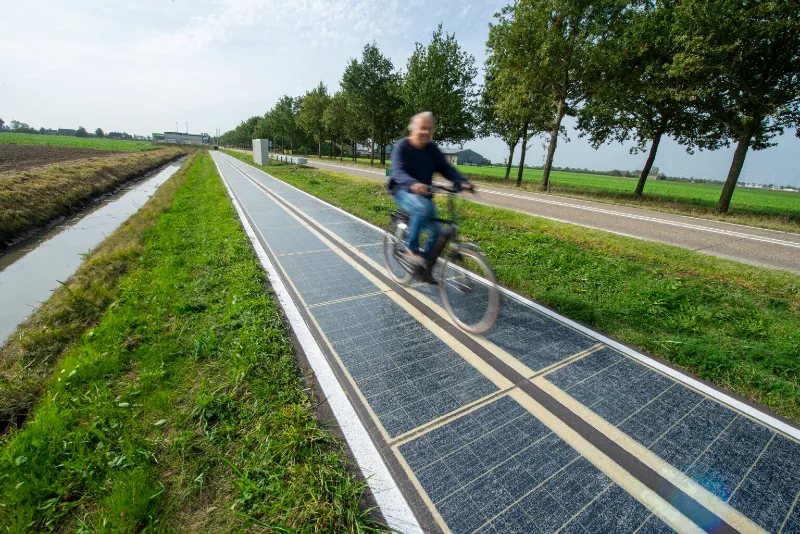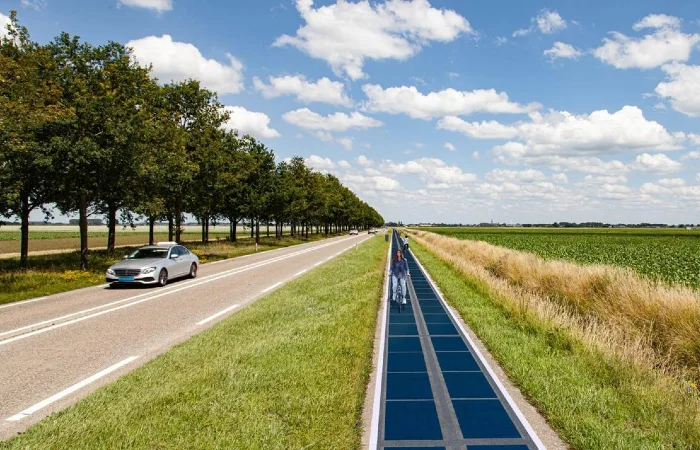In a pioneering move, the Netherlands has activated two innovative solar bike path projects, advancing the nation’s commitment to renewable energy. These current projects, initiated in 2018 by Rijkswaterstaat, a part of the Dutch Ministry of Infrastructure and the Environment, represent a creative solution to the challenge of finding new spaces for solar energy generation.
French company Colas and the Dutch BAM Royal Group have played key roles in bringing these projects to life. The paths, located in North Brabant and North Holland, cover a total of 2,000 square meters (21,527 square feet). Each path utilizes photovoltaic (PV) modules with a notable efficiency rate of 21% per square meter. The solar cells are safeguarded by a resilient multilayer resin, and the electrical system is designed for minimal wiring, enhancing both efficiency and safety.

Energy Production and Cost Analysis
Collectively, these paths are expected to generate 160 MWh of renewable energy annually. Although the exact cost of these projects hasn’t been publicly disclosed, the investment in solar bike paths is likely to be substantial. The cost of integrating PV technology into existing infrastructure typically includes the price of solar panels, installation, and maintenance.
For comparison, the standard cost of solar panel installation in residential settings can range from $2.50 to $3.50 per watt. Given the specialized nature of these bike paths, costs are higher due to the need for durable, weather-resistant materials and the integration of the panels into the paths’ surfaces.
Previous Endeavors and Ongoing Debates
The concept of solar roads isn’t new in the Netherlands. A solar-equipped bike path near Amsterdam was introduced in 2016, followed by another in Utrecht in 2020. Despite these developments, the economic feasibility of solar roads continues to spark debate. Critics question the cost-effectiveness and durability of these installations compared to traditional solar farms.
In response to land scarcity for large-scale solar projects, the Dutch government is exploring the “Zon op Infra” plan. This ambitious project aims to test solar power production on road infrastructures, including solar installations along highways and noise barriers. It’s part of a broader strategy to utilize non-traditional surfaces for renewable energy generation.
Costs? Here's What We Do Know

While the financials for the latest solar bike path in the Netherlands hasn’t been released, we can use the previous construction figures to form an educated guess. The image above features a worker with SolaRoad installing a bike path in the Netherlands in 2016. The 330 feet of solar panels cost roughly $3.7 million and, in the best conditions, generates enough electricity to power… three households. Not very cost-effective. In fact, in the United States, that’s over 1,000 times more expensive than the price of rooftop solar electricity.
Exploring Alternative Surfaces for Solar Projects
The Netherlands faces a unique challenge due to limited available land for traditional PV plants. To address this, research institutes and private companies are investigating the potential of solar projects on non-agricultural lands. This includes exploring options like dikes, rooftops, and both onshore and offshore water surfaces, expanding the scope of renewable energy generation in innovative ways.
More To Discover
- Solving Island Energy By Going To The Past: 140-Year-Old Technology Offers New Hope for Clean, Unlimited Power
- Global Leaders Convene in Kenya to Forge Historic Plastic Pollution Treaty
- Is Vertical Agrivoltaics the Next Big Green Revolution, or Just a Passing Trend? A California Winery Is Going To Find Out
- The People of Ghana Are Drowning In Mountains Of Our Used Clothes
In summary, the Netherlands’ foray into solar bike paths proves its commitment to renewable energy and innovative solutions. While challenges regarding costs and feasibility remain, these efforts mark significant steps in the nation’s journey towards a more sustainable future.
Whether these new solar paths will prove financially practical is another story entirely, and one we won’t know for some time.





















